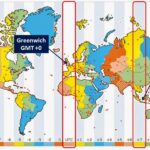USA time is a fundamental concept that governs our daily lives, influencing everything from work and communication to travel and entertainment. In a country as vast as the United States, time takes on additional layers of complexity. The United States spans multiple time zones, each one reflecting a different slice of the Earth’s 24-hour rotation. From the bustling streets of New York in the Eastern Time Zone to the tranquil coasts of Hawaii, understanding ‘USA time’ means understanding a system that accommodates regional differences while maintaining national cohesion.
Overview of Time Zones in the United States
The United States spans a vast geographical area, which necessitates the division of the country into multiple time zones. These usa time zones help synchronize daily life across different regions, making travel, business, and communication more efficient. There are six primary time zones in the U.S. mainland and additional time zones used by U.S. territories.
The Six Standard Time Zones
The continental United States is primarily divided into four standard usa time zones: Eastern, Central, Mountain, and Pacific. However, when you include Alaska and Hawaii, the count increases to six. Each time zone typically represents one hour of difference from its neighbor. The Eastern Time Zone (ET) is the earliest, followed by Central (CT), Mountain (MT), Pacific (PT), Alaska (AKT), and Hawaii-Aleutian (HAT).
Daylight Saving Time in the USA
Daylight Saving Time (DST) adds another layer of complexity. From spring through early fall, most states set clocks forward by one hour to make better use of daylight in the evenings. The shift begins on the second Sunday in March and ends on the first Sunday in November. Not all states observe DST Arizona and Hawaii are notable exceptions.
Importance of Time in Daily Life across the USA
USA Time plays a fundamental role in shaping the routines, responsibilities, and rhythms of daily life throughout the United States. With its vast geography and diverse population, the country relies heavily on structured timekeeping to maintain order and efficiency. From coast to coast, time determines school schedules, work hours, transportation systems, and television programming. In business, synchronized time across zones is essential for trading, virtual meetings, and customer service. Punctuality is deeply valued in American culture, often seen as a sign of respect and professionalism. Whether catching a flight, attending a job interview, or tuning in to a national broadcast, the importance of usa time is woven into the fabric of American society; helping millions stay connected and coordinated each day.
Conclusion
The concept of ‘USA time’ is far more intricate than it appears at first glance. It encompasses a system of time zones carefully designed to reflect geographical and social realities. With the added dimension of Daylight Saving Time and exceptions in various states, usa time keeping in the U.S. is both fascinating and essential. Understanding these time differences helps in everything from planning cross-country travel to coordinating business operations. As technology advances, time synchronization has become more seamless, yet the regional differences in timekeeping continue to remind us of the country’s geographical diversity.
FAQ’s About usa time
What are the main time zones in the USA?
The U.S. has six main time zones: Eastern, Central, Mountain, Pacific, Alaska, and Hawaii-Aleutian, each one hour apart.
Does the USA observe Daylight Saving Time?
Yes, most states do, except for Arizona and Hawaii, which remain on standard time year-round.
How do time zones affect communication in the USA?
Time differences, like the three hours between New York and Los Angeles, require planning for meetings and events.
Why doesn’t the USA use one time zone?
The country is too large; multiple time zones keep daily life aligned with natural daylight in each region.
How can I check the current USA time?
Use digital clocks, smartphone apps, or world clock websites for real-time updates across U.S. time zones.



